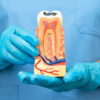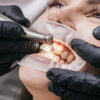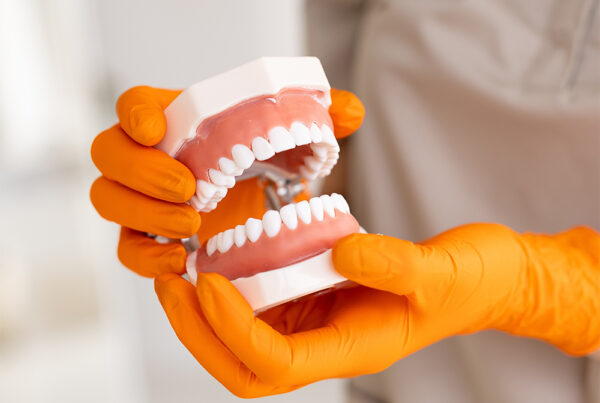Terminology Of Terms On Dental Health
Abscess On Dental Health
An abscess is a dental health condition that can cause severe pain and discomfort. It is caused by an infection in the mouth, which can occur due to tooth decay, trauma, or gum disease. An abscess can form in the gums, around a tooth, or even in the jawbone.
When an abscess forms, it causes inflammation and swelling of the affected area. This is accompanied by severe pain that can range from dull to sharp and throbbing. Other symptoms include bad breath, fever, difficulty opening your mouth wide, facial swelling, and a bitter taste in your mouth.
If left untreated, an abscess can lead to serious complications such as spreading of the infection to other parts of the body and damage to nearby teeth or bone structure. It’s important to seek treatment for an abscess as soon as possible in order to prevent further damage.
Treatment for an abscess typically involves draining the pus from the infected area and cleaning out any debris that may be present. This process may involve numbing the area with local anesthesia before making a small incision in order to allow for drainage of the pus. In some cases antibiotics may also be prescribed in order to help fight off any remaining bacteria that could cause further infection.
In addition to treating an existing abscess, it’s important to take steps towards preventing future infections from occurring. Good oral hygiene practices such as brushing twice daily with fluoride toothpaste and flossing regularly are essential for keeping your teeth healthy and free from decay or gum disease which can lead to an abscess forming. Regular visits with your dentist are also important for early detection of any potential problems before they become more serious issues like an abscess.
Gum Recession On Dental Health
Gum recession is a common dental health issue that affects many people. It occurs when the gum tissue surrounding the teeth begins to recede or pull away from the teeth, exposing more of the tooth’s root. This can cause sensitivity and discomfort, as well as making your teeth look longer than normal. Gum recession can also lead to more serious problems such as bone loss and even tooth loss if left untreated.
The main cause of gum recession is periodontal disease, which is an infection of the gums caused by bacteria in plaque buildup on the teeth. Other causes include aggressive brushing, misaligned teeth, tobacco use, genetics, and hormonal changes due to pregnancy or menopause.
If you notice any signs of gum recession such as redness or swelling of your gums, increased sensitivity to hot and cold foods or drinks, receding gums, or loose teeth, it’s important to visit your dentist right away for an evaluation. Your dentist will be able to diagnose the problem and recommend treatment options depending on the severity of your condition.
Treatment for gum recession typically involves scaling and root planing (deep cleaning) followed by a course of antibiotics to reduce inflammation and kill bacteria in the mouth. In some cases, surgery may be necessary to repair damaged tissue or graft new tissue onto exposed roots. If you have severe periodontal disease that has caused extensive damage to your gums and bones around your teeth, you may need a full-mouth reconstruction which includes multiple treatments over several months.
Preventing gum recession is possible with good oral hygiene habits such as brushing twice daily with a soft-bristled toothbrush and flossing once a day. You should also visit your dentist regularly for checkups and cleanings so they can monitor any changes in your oral health over time. Additionally, quitting smoking can help reduce your risk for gum disease since smoking increases inflammation in the mouth which can lead to gum recession over time.
Fluorosis On Dental Health
Fluorosis is a condition that affects the health of your teeth. It occurs when too much fluoride is ingested during tooth development, leading to changes in the appearance of the enamel. Fluorosis can range from barely noticeable white spots on the teeth to more severe discoloration and pitting of the enamel.
Fluoride is an important mineral for dental health, as it helps strengthen teeth and prevent cavities. However, too much fluoride can cause fluorosis, which can lead to discolored or pitted teeth. In most cases, fluorosis does not affect the function of the teeth and does not require treatment.
The best way to prevent fluorosis is to limit exposure to fluoride during tooth development. This typically occurs between birth and age 8, so it’s important for parents to monitor their children’s intake of fluoride during this time period. The American Dental Association recommends that children under 6 years old use no more than a pea-sized amount of toothpaste when brushing their teeth twice a day with adult supervision. Children should also be encouraged to spit out any excess toothpaste after brushing rather than swallowing it.
In addition, parents should be aware of sources of fluoride other than toothpaste that may contribute to fluorosis such as drinking water, infant formula reconstituted with fluoridated water, certain foods and beverages processed with fluoridated water, dietary supplements containing fluoride and professional topical applications such as varnishes or gels applied at dental visits.
Gingivitis On Dental Health
Gingivitis is a common and mild form of gum disease that causes inflammation of the gums. It occurs when plaque, a sticky film of bacteria, builds up on the teeth near the gum line. If left untreated, gingivitis can lead to more serious forms of gum disease, such as periodontitis.
Gingivitis is one of the most common dental health issues in adults. According to the Centers for Disease Control and Prevention (CDC), nearly half of all adults aged 30 or older have some form of gum disease.
The good news is that gingivitis is reversible with proper oral hygiene and regular dental visits. The key to preventing and treating gingivitis is to remove plaque from your teeth before it hardens into tartar, which can only be removed by a dentist or hygienist.
Nitrous Oxide
Nitrous oxide, commonly known as laughing gas or sweet air, is a colorless, non-flammable gas with a slightly sweet odor and taste. It is used in medicine for anesthesia and pain relief, and in automotive racing to increase engine power. Nitrous oxide has been used recreationally since the late 18th century when it was discovered that inhaling the gas produced euphoria.
In medical settings, nitrous oxide is used as an anesthetic agent to reduce pain during procedures such as childbirth or dental work. The gas works by reducing the patient’s awareness of pain while still allowing them to remain conscious. Nitrous oxide can also be used to treat depression and anxiety in some cases. In addition, it has been found to have anti-inflammatory properties which may be beneficial for those suffering from chronic pain conditions such as arthritis or fibromyalgia.
Amalgam
Amalgam is a type of dental filling used to repair cavities and other damage to teeth. It is made from a combination of metals, including silver, tin, copper, and mercury. Amalgam fillings are strong and durable, making them an ideal choice for restoring teeth that have been damaged by decay or trauma.
The use of amalgam as a dental filling material dates back to the early 1800s. Since then, it has become one of the most commonly used materials in dentistry due to its strength and affordability. While there has been some controversy surrounding the safety of amalgam fillings over the years, many studies have shown that they are safe for use in adults and children alike.
Amalgam fillings are relatively easy to place in the mouth. First, your dentist will remove any decay or debris from the affected tooth before placing a thin layer of amalgam on top. This layer is then shaped into the desired shape before being hardened with a special light or heat source. Once hardened, your dentist will polish the filling so that it blends in with your natural tooth structure.
Burning Man Syndrome On Dental Health
Burning Man Syndrome is a condition that affects the dental health of many people. It is characterized by a burning sensation in the mouth, usually accompanied by a metallic taste and pain in the teeth and gums. This condition can be caused by a variety of factors, including dry mouth, certain medications, poor oral hygiene, and even stress.
The most common symptom of Burning Man Syndrome is a burning sensation in the mouth. This feeling can range from mild to severe and may last for several minutes or hours. In some cases, it may even persist for days or weeks. The sensation can occur anywhere in the mouth but is typically felt on the tongue, lips, gums, and roof of the mouth. In addition to this burning sensation, many people also experience a metallic taste in their mouths.
Other symptoms associated with Burning Man Syndrome include tooth sensitivity or pain when eating or drinking hot or cold foods and beverages; gum inflammation; bad breath; cracked lips; dryness of the mouth; difficulty swallowing; and sores on the tongue or inside of the cheeks. If left untreated, these symptoms can lead to further dental problems such as cavities and gum disease.
Fortunately, there are ways to manage Burning Man Syndrome and reduce its effects on your dental health. One way is to practice good oral hygiene habits such as brushing twice daily with fluoride toothpaste and flossing at least once per day. Additionally, you should visit your dentist regularly for check-ups so that any issues can be identified early on before they become more serious problems. Drinking plenty of water throughout the day will also help keep your mouth moist which can help reduce discomfort from dryness or burning sensations.
Bleaching On Dental Health
Bleaching is a popular and effective way to whiten teeth and improve the overall appearance of your smile. It is a safe, non-invasive procedure that can be done in the comfort of your own home or at your dentist’s office.
The process of bleaching involves applying a special solution to the teeth that contains hydrogen peroxide or carbamide peroxide. This solution helps to break down the stains on the enamel and dentin layers of the teeth, making them appear whiter and brighter. The amount of time it takes for the bleaching process to work depends on how deep the stains are and how long they have been there.
At-home bleaching kits are available over-the-counter or from your dentist. These kits usually include trays filled with a special bleaching gel that you place over your teeth for a certain amount of time each day. You may also need to wear a protective mouthguard while using these products to prevent any irritation from occurring in your mouth.
If you choose to have professional bleaching done, you will need to visit your dentist’s office for an appointment. During this appointment, your dentist will apply a higher concentration of bleach directly onto your teeth, which will help to remove more stubborn stains faster than at-home treatments can do alone. Your dentist may also use special lights or lasers during this procedure to help speed up the whitening process even further.
No matter which type of bleaching you choose, it is important that you follow all instructions provided by your dentist carefully in order to get the best results possible from this treatment option. Additionally, it is important that you practice good oral hygiene habits such as brushing twice daily and flossing regularly in order to maintain the results of bleaching for as long as possible.
Bicuspids On Dental Health
Bicuspids are an important part of dental health. They are the teeth located between the molars and the incisors in the upper and lower jaws. Bicuspids play a key role in chewing, grinding, and biting food.
Bicuspids have two pointed cusps on their biting surface that help to cut and grind food into smaller pieces. They also help to hold food in place while it is being chewed. Bicuspids are larger than incisors but smaller than molars.
In addition to their role in eating, bicuspids also play an important role in the alignment of your teeth. When your bicuspids come together properly, they form a line that helps keep your other teeth in proper alignment. If your bicuspids don’t come together properly, it can cause problems with your bite and lead to other dental issues such as crooked or crowded teeth.







